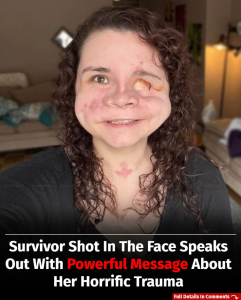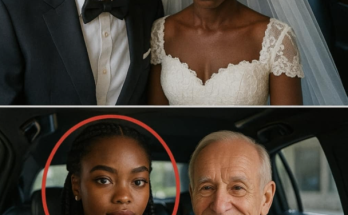Survivor Shot in the Face Speaks Out With Powerful Message About Her Horrific Trauma
The morning of July 12, 2022, began like any other for Kayla Monroe, a 26-year-old nursing student in Denver, Colorado. She had coffee brewing in the kitchen, music playing in the background, and dreams of becoming a trauma nurse dancing in her head. But by the end of the day, she would find herself fighting for her life—after being shot point-blank in the face by a stranger during a botched carjacking.
Two years later, with metal plates in her jaw, permanent scars across her cheek, and a voice altered by reconstructive surgery, Kayla has found something she once thought was lost forever: her strength. And now, she’s using her voice—however changed—to speak up, heal others, and reclaim power from the darkest night of her life.
The Day Everything Changed
“I still remember the smell of rain,” Kayla says softly. “It had just started to drizzle as I walked to my car.”
She was leaving her evening shift at the hospital when the attack happened. A man approached her in the dim parking garage and demanded her car keys. Kayla handed them over, but before she could back away, he raised a small pistol and pulled the trigger.
“I didn’t have time to scream,” she says. “There was a flash, a crack—and then everything went black.”
The bullet shattered her left cheekbone, tore through her jaw, and exited near her ear. Miraculously, it missed her brain by millimeters. Paramedics said she was conscious when they arrived, her hands covered in blood, her voice gurgling unintelligibly through broken teeth. It took six hours of emergency surgery to stabilize her.
Doctors later told her she shouldn’t have survived.
The Road Back
Kayla woke up in the ICU three days later, her face swollen beyond recognition, her mouth wired shut, and her family huddled around her. She couldn’t speak. She couldn’t eat. She couldn’t cry—at least not in the way she used to. “All I could do was blink,” she recalls. “And even that hurt.”
Over the next 18 months, Kayla underwent nine surgeries—bone grafts, skin reconstruction, nerve repair. She had to learn to speak again, to chew again, to smile again. And yet, the hardest part wasn’t physical.
“It was the silence,” she says. “The feeling of being trapped in a body I didn’t recognize. I was afraid to look in mirrors. Afraid I would never feel like me again.”
There were nights she begged her mother to turn off the lights and sit beside her in the dark, just so she wouldn’t feel alone. There were weeks she couldn’t face visitors, and months where PTSD left her waking up in cold sweats, reliving the moment over and over again.
Finding Her Voice Again
Despite it all, Kayla refused to disappear. With the support of her therapists, family, and a trauma support group, she began slowly putting the pieces of herself back together. She took online classes from her hospital bed. She journaled. She painted. And when her voice was strong enough, she started recording video diaries on her phone—not for anyone else at first, but for herself.
“It was like I was meeting me again,” she says. “Even if my voice cracked, even if my mouth didn’t move like it used to—I was still there. I was still Kayla.”
In late 2023, she shared one of those videos online, telling her story in raw, unfiltered detail. It went viral within days. Her message was simple, but powerful:
“They tried to silence me. But I’m still speaking.”
Thousands of messages flooded in—survivors of violence, women facing trauma, people dealing with scars they were told to hide. They thanked her. They saw themselves in her. And Kayla realized her story wasn’t just hers anymore.
A New Purpose
Today, Kayla is back in school, just months away from finishing her degree in nursing. She specializes in trauma care—not despite what happened to her, but because of it. She knows the panic in a patient’s eyes when they wake up and feel less than human. She knows the weight of a face wrapped in gauze. And she knows what to say when no one else does.
“I tell them: ‘You’re still you. No matter what’s changed.’”
She’s also become a powerful advocate for gun violence survivors, speaking at high schools, hospitals, and conferences. She’s been featured on national news, not for what happened to her—but for what she’s doing now.
“I never want anyone to think their life ends with a scar,” she says. “Your life begins when you choose to fight for it.”
The Man Who Did It
Kayla’s attacker was arrested two weeks after the shooting. He was 19 years old, with a history of petty theft and gang involvement. At his trial, he showed little remorse. Kayla chose not to attend most of the proceedings, but she did make a victim impact statement on the final day.
She stood in court, scars visible, voice steady, and told him:
“You broke my face. You broke my trust. But you didn’t break my spirit. And you will never take my voice from me again.”
The courtroom fell silent. The judge sentenced him to 22 years without parole.
More Than Her Scars
Kayla still has daily pain. Her smile is crooked. She speaks with a subtle rasp. But she laughs louder now than ever before.
“I’m not here to be pitied,” she insists. “I’m here to be seen.”
She has no interest in hiding her story or her face. In fact, she posts selfies regularly, showing her healing journey. The comments are filled with support: “You’re radiant.” “You’re a warrior.” “You’re my hero.”
But Kayla shrugs off praise. She says she’s just someone who made a choice—to live, to speak, and to show others that survival isn’t just possible. It’s powerful.
Conclusion: Scars and Strength
What happened to Kayla Monroe should never have happened. One senseless act of violence altered her life forever. But in the wreckage, she discovered a strength she never imagined. A voice more powerful than any silence. A purpose deeper than fear.
And now, every time she steps into a hospital, every time she shares her story with a stranger, every time she smiles despite the pain—she reminds the world:
“You can’t always choose what happens to you. But you can choose who you become because of it.”
At 28, Kayla Monroe is no longer just a survivor.
She’s a symbol of what it means to rise again—and roar.

